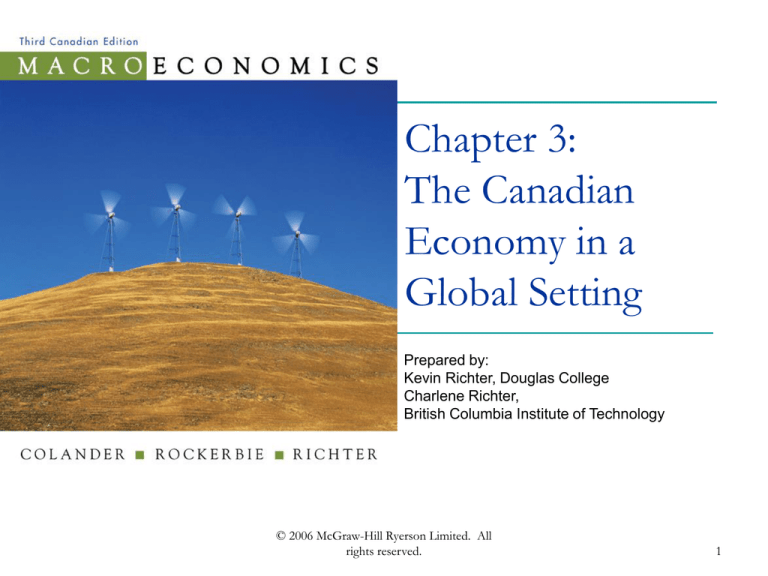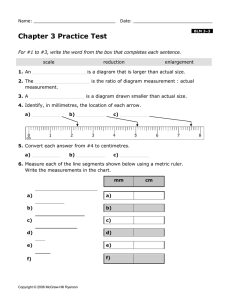
Chapter 3:
The Canadian
Economy in a
Global Setting
Prepared by:
Kevin Richter, Douglas College
Charlene Richter,
British Columbia Institute of Technology
© 2006 McGraw-Hill Ryerson Limited. All
rights reserved.
1
The Canadian Economy
Ultimately the Canadian economy’s strength
is its people and its other resources.
The Canadian economy is far from perfect.
© 2006 McGraw-Hill Ryerson Limited. All
rights reserved.
2
The Canadian Economy
The Canadian economy is divided into three
groups: business, households, and
government.
© 2006 McGraw-Hill Ryerson Limited. All
rights reserved.
3
The Canadian Economy
Households supply factors of production to
business and are paid by business for doing
so.
This takes place in the factor market.
© 2006 McGraw-Hill Ryerson Limited. All
rights reserved.
4
The Canadian Economy
Business produces goods and services and
sells them to households and government.
This takes place in the goods market.
© 2006 McGraw-Hill Ryerson Limited. All
rights reserved.
5
The Canadian Economy
Government:
Buys goods and services from business and buys
labour services from households.
Provides services to both business and
households.
© 2006 McGraw-Hill Ryerson Limited. All
rights reserved.
6
The Canadian Economy
Government:
Gives some of its tax revenues directly back to
individuals (income redistribution).
Oversees the interaction of business and
households in the goods and factor markets.
© 2006 McGraw-Hill Ryerson Limited. All
rights reserved.
7
The Canadian Economy
© 2006 McGraw-Hill Ryerson Limited. All
rights reserved.
8
Business
Business is the name given to private
producing units in our society.
Businesses decide what to produce, how much to
produce, and for whom to produce it.
© 2006 McGraw-Hill Ryerson Limited. All
rights reserved.
9
Consumer Sovereignty and Business
Businesses produce what they believe
consumers will buy.
Consumer sovereignty means that
consumers’ wishes rule what is produced by
businesses.
© 2006 McGraw-Hill Ryerson Limited. All
rights reserved.
10
Consumer Sovereignty and Business
Before deciding to start a business, the key
question is: “Can I make a profit?”
Profit is what’s left over from total revenues
after all the appropriate costs have been
subtracted.
© 2006 McGraw-Hill Ryerson Limited. All
rights reserved.
11
Consumer Sovereignty and Business
By channeling the desire to make a profit for
the general good of society, the Canadian
economic system allows the invisible hand to
work.
© 2006 McGraw-Hill Ryerson Limited. All
rights reserved.
12
Finance and Business
By selling stocks and bonds, corporations
can finance expansions and new
investments.
The dynamic stock market allows initial public
offerings (IPOs) to quickly change value and
to make their owners rich (or poor).
© 2006 McGraw-Hill Ryerson Limited. All
rights reserved.
13
E-Commerce and the Digital
Economy
E-commerce refers to buying and selling
over the internet.
It brings people together at a low cost in a virtual
marketplace where geographical location doesn’t
matter.
It increases information, reduces the importance
of geography, and adds competitive pressure to
the ‘traditional’ economy.
© 2006 McGraw-Hill Ryerson Limited. All
rights reserved.
14
Households
Households – groups of individuals living
together and making joint decisions.
In the economy, households vote with their
dollars.
© 2006 McGraw-Hill Ryerson Limited. All
rights reserved.
15
The Power of Households
Households influence the other two economic
institutions – government and business.
© 2006 McGraw-Hill Ryerson Limited. All
rights reserved.
16
Households as Suppliers of Labour
The largest source of household income is
wages and salaries.
Households supply the labour with which
businesses produce and government
governs.
© 2006 McGraw-Hill Ryerson Limited. All
rights reserved.
17
Government
Two general roles of government are:
An actor – collects money in taxes and spends
that money on its own projects, such as
healthcare and education.
A referee – sets the rules that determine relations
between businesses and households.
© 2006 McGraw-Hill Ryerson Limited. All
rights reserved.
18
Government as an Actor
All levels of government consume about 20
percent of the nation’s total output and
employ about 800,000 persons.
© 2006 McGraw-Hill Ryerson Limited. All
rights reserved.
19
Government as an Actor
Provincial and local government employ over
450,000 workers and spend about $250
billion per year.
They spend their tax revenues on social
services, administration, education, and
roads.
© 2006 McGraw-Hill Ryerson Limited. All
rights reserved.
20
Government as an Actor
Income taxes make up 62 percent of the
federal government’s revenue, while sales
taxes make up about 20 percent.
The two largest categories of spending are
social services and debt charges.
© 2006 McGraw-Hill Ryerson Limited. All
rights reserved.
21
Income of Provincial and Local
Governments, 2003-4
© 2006 McGraw-Hill Ryerson Limited. All
rights reserved.
22
Expenditures of Provincial and Local
Governments, 2003-4
© 2006 McGraw-Hill Ryerson Limited. All
rights reserved.
23
Income of the Federal Government,
2003-4
© 2006 McGraw-Hill Ryerson Limited. All
rights reserved.
24
Expenditures of the Federal
Government, 2003-4
© 2006 McGraw-Hill Ryerson Limited. All
rights reserved.
25
Government as a Referee
Government sets the rules of interaction
between households and business.
It acts as a referee, changing the rules when
it sees fit.
It decides whether economic forces will be
allowed to operate freely.
© 2006 McGraw-Hill Ryerson Limited. All
rights reserved.
26
Government as a Referee
The big question: What referee role should
the government play in the economy?
© 2006 McGraw-Hill Ryerson Limited. All
rights reserved.
27
International Issues
International issues must be taken into
account in just about any economic decision
a country or a firm faces.
© 2006 McGraw-Hill Ryerson Limited. All
rights reserved.
28
International Issues
Global corporations – corporations with
substantial operations in both production and
sales in more than one country.
© 2006 McGraw-Hill Ryerson Limited. All
rights reserved.
29
International Issues
Global corporations offer great benefits for
nations.
Global corporations create jobs, bring new
ideas and new technologies to a country, and
provide competition for domestic companies.
© 2006 McGraw-Hill Ryerson Limited. All
rights reserved.
30
International Issues
There is no global government to regulate or
control global corporations.
They can shift operations to another country
if they don’t like the policies of the host
country.
© 2006 McGraw-Hill Ryerson Limited. All
rights reserved.
31
International Issues
Global corporations sometimes act as
governments unto themselves – they can
dominate the economy of a small nation.
© 2006 McGraw-Hill Ryerson Limited. All
rights reserved.
32
International Trade
The volume and value of international trade
have grown substantially over the last
century.
There have been significant fluctuations in
trade around the increasing trend.
© 2006 McGraw-Hill Ryerson Limited. All
rights reserved.
33
International Trade
Fluctuations in world trade result in part from
fluctuations in world output.
Fluctuations are also explained in part by
trade restrictions that nations have imposed
from time to time.
© 2006 McGraw-Hill Ryerson Limited. All
rights reserved.
34
Differences in the Importance of
Trade
Exports - the value of goods sold abroad.
Imports - the value of goods purchased
abroad.
© 2006 McGraw-Hill Ryerson Limited. All
rights reserved.
35
What and With Whom Canada Trades
Canada’s primary trading partners are the
United States and the European Union.
The majority of Canadian exports and imports
involve manufactured goods.
© 2006 McGraw-Hill Ryerson Limited. All
rights reserved.
36
What and With Whom Canada Trades
Balance of trade – the difference between
the value of exports and the value of imports.
Balance of trade contains two components:
The merchandise trade balance
The services balance
© 2006 McGraw-Hill Ryerson Limited. All
rights reserved.
37
What and With Whom Canada Trades
Trade deficit – imports exceed exports.
Trade surplus – exports exceed imports.
© 2006 McGraw-Hill Ryerson Limited. All
rights reserved.
38
What and With Whom Canada Trades
Over the past 30 years, Canada’s services
trade balance has been negative. Canada’s
merchandise trade balance has been mostly
positive.
The overall balance of trade has been positive,
since the merchandise trade balance
exceeded the balance in services.
© 2006 McGraw-Hill Ryerson Limited. All
rights reserved.
39
Canadian Balance of Trade
© 2006 McGraw-Hill Ryerson Limited. All
rights reserved.
40
Canadian Exports by Region, 2003
© 2006 McGraw-Hill Ryerson Limited. All
rights reserved.
41
Canadian Imports by Region, 2003
© 2006 McGraw-Hill Ryerson Limited. All
rights reserved.
42
Debtor and Creditor Nations
The Current account balance measures
trade in goods and services and includes the
interest we pay to foreigners.
© 2006 McGraw-Hill Ryerson Limited. All
rights reserved.
43
International Trade Differs From
Domestic Trade
International trade involves potential barriers
to trade.
Quotas are limitations on how much of a good
can be shipped into a country.
Tariffs are taxes on imports.
Non-tariff barriers are indirect regulatory
restrictions on imports and exports.
© 2006 McGraw-Hill Ryerson Limited. All
rights reserved.
44
International Trade Differs From
Domestic Trade
International trade can involve multiple
currencies that are bought and sold in
foreign exchange markets.
© 2006 McGraw-Hill Ryerson Limited. All
rights reserved.
45
International Trade Differs From
Domestic Trade
The exchange rate is the rate at which one
currency is traded for another.
The exchange rate is determined by the
demand and supply for the currency.
© 2006 McGraw-Hill Ryerson Limited. All
rights reserved.
46
Institutions Supporting Free Trade
Most economists generally favour free trade
and oppose trade restrictions.
© 2006 McGraw-Hill Ryerson Limited. All
rights reserved.
47
Free Trade Organizations
Despite political pressures to restrict trade,
nations have entered into a variety of
international agreements and organizations.
© 2006 McGraw-Hill Ryerson Limited. All
rights reserved.
48
Free Trade Organizations
The World Trade Organization (WTO) is
committed to getting nations to agree not to
impose new tariffs or other trade restrictions
except under certain limited conditions.
© 2006 McGraw-Hill Ryerson Limited. All
rights reserved.
49
Free Trade Organizations
The WTO is the successor to the General
Agreement on Tariffs and Trade (GATT) –
an agreement among many subscribing
nations on certain conditions of international
trade.
© 2006 McGraw-Hill Ryerson Limited. All
rights reserved.
50
Free Trade Organizations
The push for free trade has a geographic
dimension.
Groups of nations have formed free trade
associations – groups of nations that have
reduced or eliminated trade barriers among
themselves.
© 2006 McGraw-Hill Ryerson Limited. All
rights reserved.
51
Free Trade Organizations
Examples are the European Union (EU) and
the North American Free Trade Agreement
(NAFTA).
NAFTA – Canada-U.S.-Mexico free trade
zone that is phasing in reductions in tariffs.
© 2006 McGraw-Hill Ryerson Limited. All
rights reserved.
52
International Economic Policy
Organizations
There is no international counterpart to a
nation’s federal government.
Any meeting of a group of nations to discuss
trade policy is voluntary.
There is no international body that has
powers of compulsion.
© 2006 McGraw-Hill Ryerson Limited. All
rights reserved.
53
International Economic Organizations
Governments have developed a variety of
international institutions to promote
negotiations and coordinate economic
relations.
© 2006 McGraw-Hill Ryerson Limited. All
rights reserved.
54
International Economic Organizations
International organizations that encourage
international cooperation include:
The United Nations (UN) has no ability to tax
and no ability to independently impose its will on
its members.
© 2006 McGraw-Hill Ryerson Limited. All
rights reserved.
55
International Economic Organizations
International organizations that encourage
international cooperation include:
The World Bank – a multinational, international
financial institution that works with developing
countries to secure low-interest loans.
© 2006 McGraw-Hill Ryerson Limited. All
rights reserved.
56
International Economic Organizations
International organizations that encourage
international cooperation include:
The International Monetary Fund (IMF) – a
multinational, international financial institution
concerned primarily with monetary issues.
© 2006 McGraw-Hill Ryerson Limited. All
rights reserved.
57
International Economic Organizations
There are also informal organizations:
Group of Five – (Japan, Germany, Britain,
France, and the U.S.) –meets to promote
negotiations and coordinate economic
relations among nations.
© 2006 McGraw-Hill Ryerson Limited. All
rights reserved.
58
International Economic Organizations
Group of Ten – sees the addition of Belgium,
Canada, Italy, the Netherlands, Sweden,
Switzerland to the Group of Five.
They do much the same work as the Group of
Five.
© 2006 McGraw-Hill Ryerson Limited. All
rights reserved.
59
International Economic Organizations
Group of Twenty – consists of the Group of
Ten plus 10 of the leading lesser developed
countries.
They address international monetary and financial
issues.
© 2006 McGraw-Hill Ryerson Limited. All
rights reserved.
60
The Canadian Economy in A
Global Setting
End of Chapter 3
© 2006 McGraw-Hill Ryerson Limited. All
rights reserved.
61




